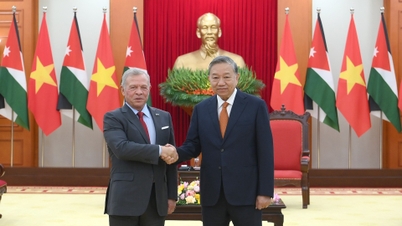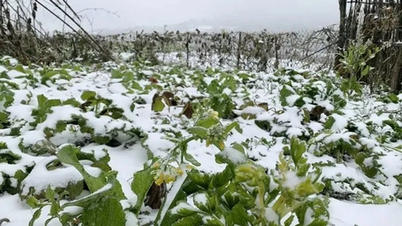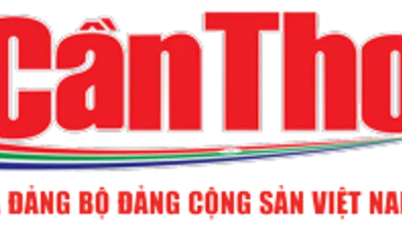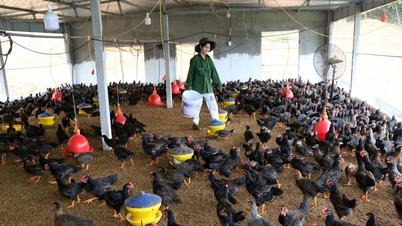Orientation of development towards modernity and autonomy
According to the World Health Organization (WHO), the pharmaceutical industry is a fundamental manufacturing industry, providing raw materials for the pharmaceutical industry and many other fields such as functional foods, pharmaceutical cosmetics, agriculture , and chemicals. However, in Vietnam, this industry is still in its early stages of development, small in scale, and with limited technology.
Data from the Department of Chemicals (Ministry of Industry and Trade) shows that domestic raw materials for drug production only meet about 5% of the demand for modern drugs and 20% for oriental drugs, the rest still has to be imported while Vietnam has a great advantage in medicinal resources. The whole country has more than 5,000 medicinal plant species, many of which are rare such as Ngoc Linh ginseng, wild ginseng, red pine, barberry... Many medicinal plant growing areas have been established and brought about clear results, such as Ngoc Linh ginseng in Kon Tum - Quang Nam, cinnamon and star anise in Yen Bai , Lang Son, cardamom in Lao Cai, turmeric in Nghe An. However, the development of medicinal plants is still fragmented, lacking connections and not linked to deep processing industry.

Vietnam has more than 5,000 plants that can be used as medicinal herbs.
In order to gradually improve the capacity for self-sufficiency in pharmaceuticals and pharmaceutical ingredients, on March 17, 2021, the Prime Minister issued Decision No. 376/QD-TTg approving the "Program for development of domestically produced pharmaceutical and medicinal materials industry by 2030, with a vision to 2045". The program aims that by 2025, domestically produced drugs will meet 75% of demand and 60% of market value; by 2030, it will reach 80% in quantity and 70% in value.
To implement that policy, the Ministry of Science and Technology has presided over the development and implementation of the National Key Science and Technology Program code KC.11/21-30 "Research on application and development of advanced technology serving the pharmaceutical and chemical industry", approved under Decision No. 1255/QD-BKHCN dated July 14, 2022.
The KC.11/21-30 program focuses on supporting research, application and mastery of advanced technologies in synthesis, extraction and purification of active ingredients; developing production processes for generic drugs, drugs from medicinal herbs and medical biological products; at the same time, encouraging businesses to invest in research and development (R&D), cooperate with domestic and foreign institutes and schools to create high-value, international-quality products.
According to the Ministry of Science and Technology, this is one of the key programs that "paves the way" for the formation of a modern pharmaceutical industry, based on high technology and domestic scientific knowledge, thereby gradually reducing import dependence and moving towards self-sufficiency in pharmaceutical ingredients.
Linking four players - developing the medicinal value chain
For sustainable development, the pharmaceutical industry needs synchronous coordination between "four houses": State - Scientists - Enterprises - Farmers. In which, the State guides and perfects policies, Scientists research and transfer technology, enterprises invest in production and processing, and farmers are the direct subjects creating quality raw material areas.
Some linkage models have yielded positive results, such as cooperation between pharmaceutical enterprises and cooperatives and people growing medicinal plants according to GACP-WHO standards. Medicinal products are of higher quality, increased in value, people have stable livelihoods, and businesses have proactive input materials.
To expand this model, there needs to be more investment incentive policies, financial support, tax incentives, human resource training and infrastructure investment for pharmaceutical industrial zones and clusters. The formation of concentrated medicinal material areas associated with processing plants, research centers and quality testing will help create a closed value chain, reduce costs and enhance the competitiveness of Vietnamese products.
The pharmaceutical industry is a high value-added sector, spreading strongly to many other sectors such as basic chemicals, mechanical engineering, agriculture, and medicine. When the domestic raw material production capacity is improved, Vietnam will not only reduce imports but also move towards exporting raw materials and pharmaceutical products that meet international standards.

By 2045, Vietnam's pharmaceutical industry will become a high-tech, modern, competitive industry and participate in the global pharmaceutical value chain.
According to the direction of the Ministry of Science and Technology, through the KC.11/21-30 Program, domestic research organizations and enterprises will be supported to develop technology for extracting and refining natural active ingredients, pharmaceutical biotechnology, nanotechnology and modern formulation, key factors to form "Made in Vietnam" pharmaceutical products and pharmaceutical ingredients with high quality and competitive prices.
Along with technology development, it is necessary to promote the development of technical standards and regulations, support businesses to achieve GMP-WHO, EU-GMP or Japan-GMP certification; at the same time, strengthen communication and encourage people to use domestic drugs through programs such as "Vietnamese people prioritize using Vietnamese drugs".
Vietnam has all the conditions to develop a self-sufficient pharmaceutical industry: abundant medicinal resources, qualified medical and pharmaceutical human resources, support policies from the State, along with key research programs such as KC.11/21-30. The important thing is to effectively connect research - production - market, promote innovation and international cooperation.
When science and technology policies and programs are implemented synchronously, the Vietnamese pharmaceutical industry can completely rise up, master technology, proactively source raw materials, ensure drug security, develop the socio-economy and affirm the country's position in the global pharmaceutical value chain.
Source: https://mst.gov.vn/phat-trien-cong-nghiep-hoa-duoc-nang-cao-nang-luc-tu-chu-ve-nguyen-lieu-thuoc-197251111150355391.htm


![[Photo] Highways passing through Dong Nai](https://vphoto.vietnam.vn/thumb/1200x675/vietnam/resource/IMAGE/2025/11/12/1762940149627_ndo_br_1-resize-5756-jpg.webp)

























































































![Dong Nai OCOP transition: [Article 3] Linking tourism with OCOP product consumption](https://vphoto.vietnam.vn/thumb/402x226/vietnam/resource/IMAGE/2025/11/10/1762739199309_1324-2740-7_n-162543_981.jpeg)








Comment (0)